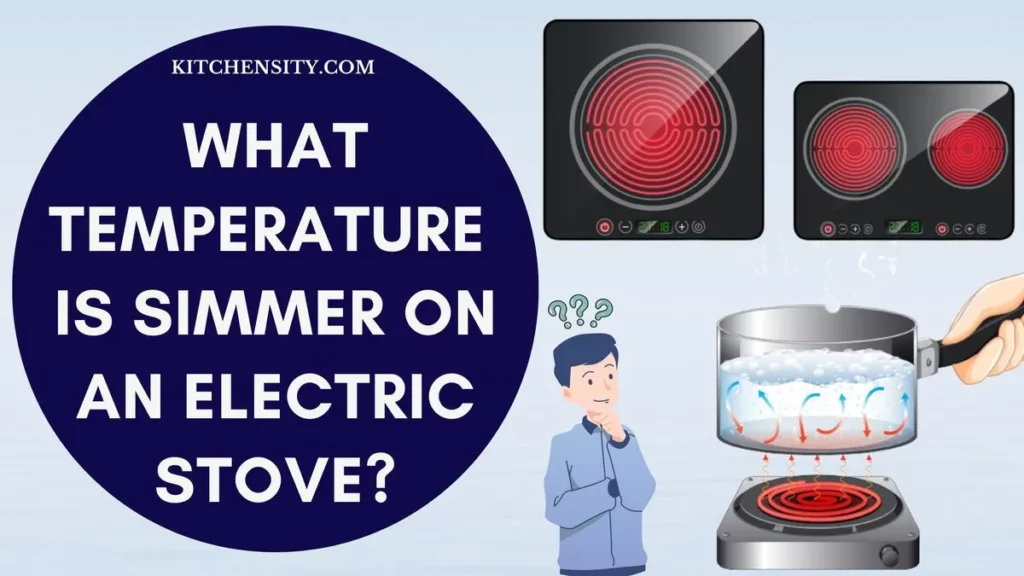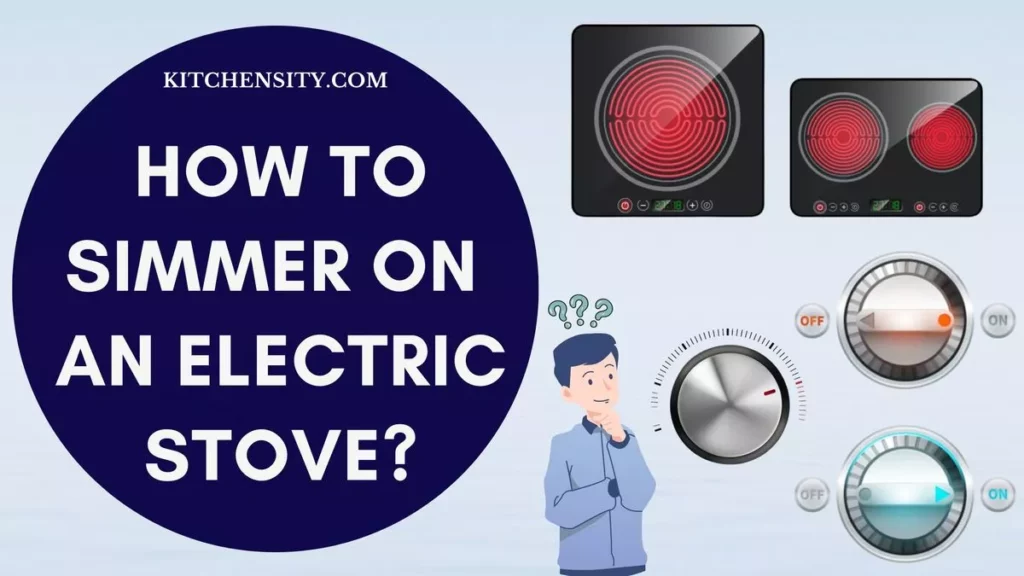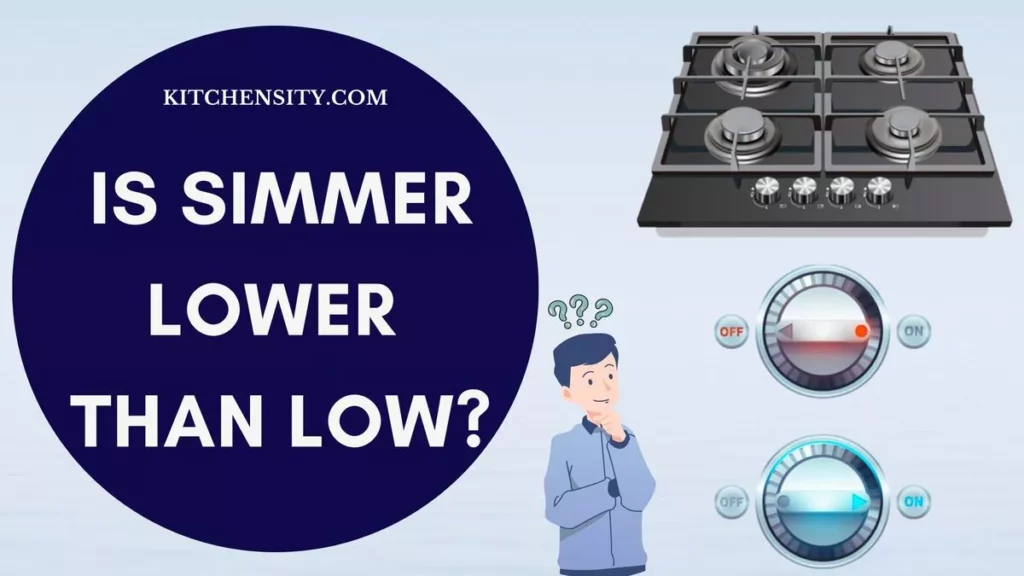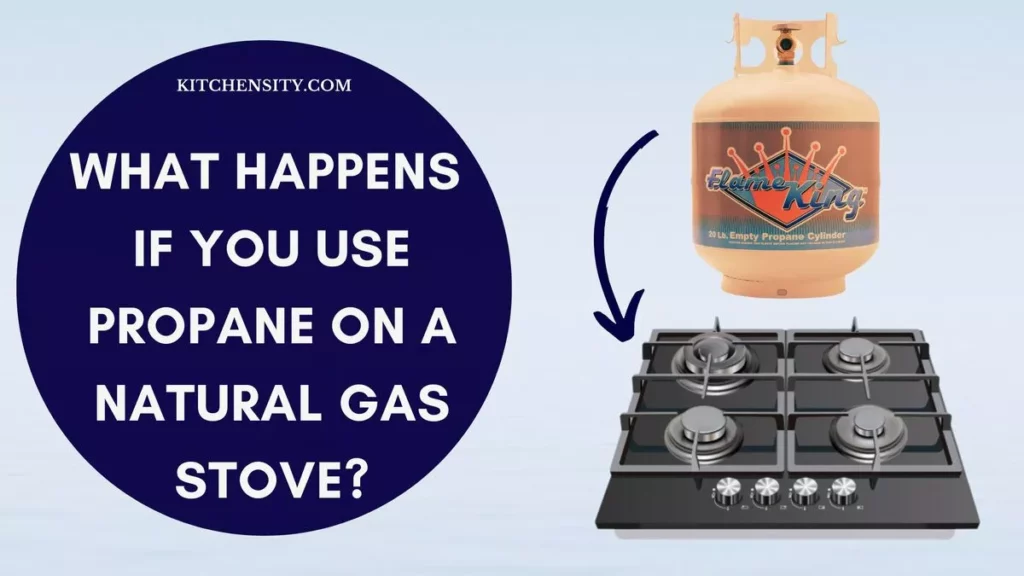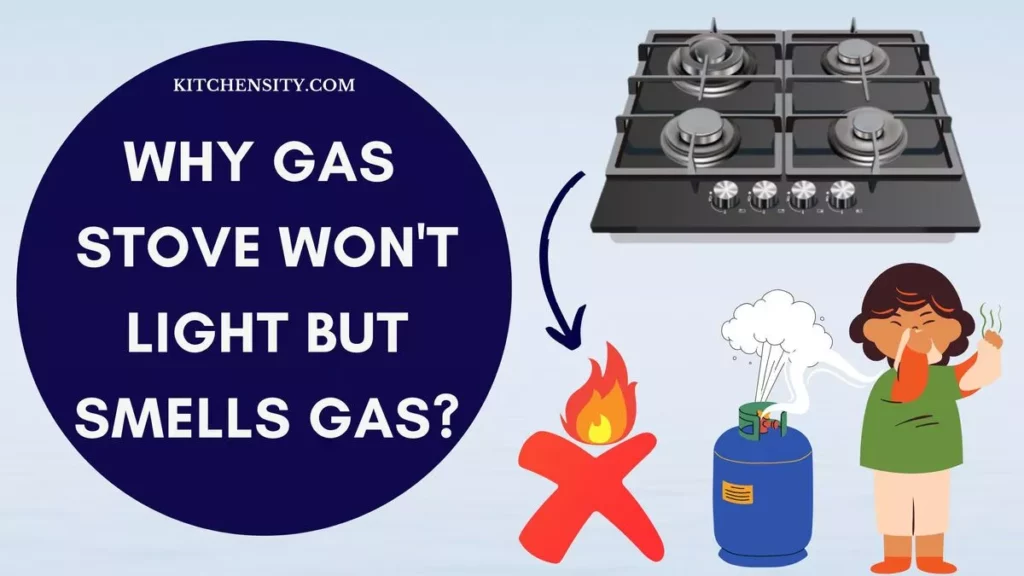Cooking on an electric stove is usually a breeze, but what do you do when your stove burner refuses to cool down? It can be puzzling and even worrisome when the heat stays on high, making your cooking plans go awry.
In this guide, we will unravel the reasons why your electric stove burner remains excessively hot and explore the simple steps you can take to fix this common kitchen dilemma. Let’s get your stove back to normal temperatures and your kitchen back to its bustling, efficient self.
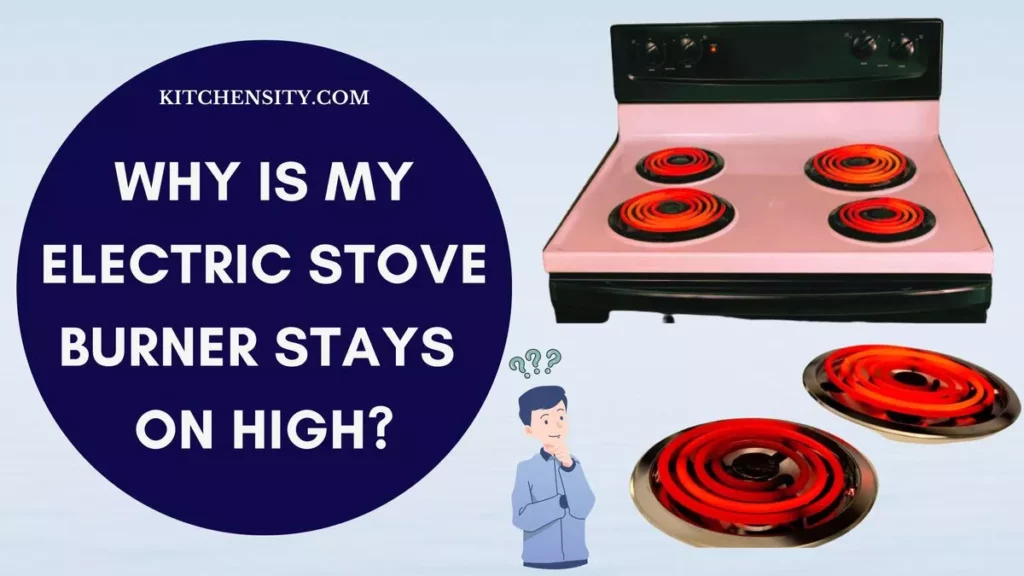
Table of Contents
- 1 Why Is My Electric Stove Burner Stays On High?
- 2 How To Solve The Problem Of Electric Stove Burner Stays On High?
- 3 Why Is My Stove Burner Too Hot On Low?
- 4 Electric Stove Burner Temperature Control
- 5 Why Is My Electric Stove Burner Not Regulating Temperature?
- 6 Does An Electric Stove Have A Reset Button?
- 7 Can You Adjust An Infinite Switch?
- 8 What Are The Symptoms Of A Bad Infinite Switch?
- 9 Final Thoughts: Why Is My Electric Stove Burner Stays On High?
- 10 Frequently Asked Questions (FAQs)
- 10.1 Is It Safe To Continue Using My Electric Stove If The Burner Stays On High?
- 10.2 Can I Fix A Faulty Control Switch Myself?
- 10.3 How Often Should I Have My Electric Stove Inspected For Potential Issues?
- 10.4 What Can I Do To Prevent Wiring Problems In My Electric Stove?
- 10.5 Are There Any Safety Tips I Should Follow While Using My Electric Stove?
Why Is My Electric Stove Burner Stays On High?
Your electric stove burner may stay on high due to a faulty control switch, wiring problems, defective temperature sensors, or issues with the control board. If this occurs, it’s crucial to avoid using the stove and seek professional assistance to diagnose and fix the problem safely.
Understanding the reasons behind this problem is crucial for effective troubleshooting. Let’s delve into the possible causes and elaborate on the solutions.
Also Read – Do Electric Stoves Use Gas?
1. Faulty Control Switch
One of the most common reasons for a burner staying on high heat is a malfunctioning control switch. The control switch regulates the flow of electricity to the burner. If it fails, it can get stuck in the “on” position, causing the burner to remain at high heat. Replacing the control switch is the solution to this issue. It’s recommended to seek professional assistance for this task unless you have experience with electrical repairs.
2. Wiring Problems
Wiring issues within the stove can disrupt the proper functioning of the burners. Damaged or frayed wires can send continuous signals to the burner, instructing it to stay on high heat. Visual inspection of the internal wiring is necessary. If any wires are found damaged, they should be replaced immediately. Handling electrical components requires expertise, so consulting a certified electrician is advisable.
3. Defective Temperature Sensor
Electric stoves are equipped with temperature sensors that monitor the burner’s heat level. A defective sensor might not accurately detect the temperature, leading to the burner staying on high heat. Testing the sensor with a multimeter can determine its functionality. If the sensor is faulty, replacing it will resolve the issue.
4. Control Board Malfunction
The control board acts as the brain of the electric stove, regulating various functions, including heat levels. If the control board malfunctions, it can send incorrect signals to the burner, causing it to remain on high heat. Replacing the control board is necessary in this case. This task requires expertise, and a certified technician should be consulted.
5. Power Supply Problems
Issues with the power supply, such as voltage fluctuations, can affect the stove’s performance. Inconsistent power supply can lead to irregularities in heat regulation. A voltage stabilizer can help mitigate this problem, ensuring a stable power flow to the stove.
So, a high-heat burner in an electric stove can stem from various issues, including faulty control switches, wiring problems, defective temperature sensors, control board malfunctions, or power supply problems.
It’s essential to identify the specific cause accurately to apply the appropriate solution. Regular maintenance and timely professional assistance can prevent and address these issues effectively, ensuring the safe and efficient operation of your electric stove.
Also Read – How To Clean Electric Stove Burners And Drip Pans?
How To Solve The Problem Of Electric Stove Burner Stays On High?
Discovering that your electric stove burner remains stuck on high heat can be concerning, but rest assured that there are steps you can take to diagnose and resolve this issue. Follow these systematic methods to solve the problem effectively:
- Check The Control Knob: Start by inspecting the control knob. Sometimes, it may be misaligned or damaged, preventing it from turning to the lower heat settings. If you find any issues, consider replacing the control knob following the manufacturer’s guidelines.
- Inspect The Control Switch: The control switch regulates the power flow to the burner. If it’s faulty, the burner might stay on high heat. Carefully examine the switch for signs of damage or wear. If you notice any problems, replacing the control switch could solve the issue. Seek assistance from a professional if you are not confident in doing it yourself.
- Examine The Wiring: Inspect the internal wiring of the stove for any visible damage or frayed wires. Damaged wiring can send continuous signals to the burner, causing it to remain on high heat. If you find any issues, it’s crucial to replace the damaged wires to restore proper functionality. Always turn off the power and consult an electrician for intricate wiring repairs.
- Test The Temperature Sensor: Use a multimeter to test the temperature sensor of the stove. A malfunctioning sensor might not accurately detect the heat level, leading to the burner staying on high heat. If the sensor is defective, replacing it with a new one can resolve the problem. Follow the manufacturer’s instructions for proper installation.
- Examine The Control Board: The control board is the central component of the stove, regulating various functions, including heat levels. If it malfunctions, it can send incorrect signals to the burner. If you suspect a control board issue, it’s best to consult a professional technician. Replacing the control board requires expertise to ensure proper functioning.
- Stabilize The Power Supply: Inconsistent power supply can cause irregularities in heat regulation. Consider using a voltage stabilizer to ensure a stable power flow to the stove. This can prevent issues arising from voltage fluctuations and maintain the proper functioning of the stove burners.
- Seek Professional Assistance: If you are unable to identify or resolve the problem on your own, it’s advisable to seek help from a certified electrician or appliance repair technician. They have the expertise and tools to diagnose complex issues and perform necessary repairs safely.
So, addressing the problem of an electric stove burner staying on high heat involves a systematic approach, starting from checking the control knob and switch to inspecting wiring, testing temperature sensors, and examining the control board. Stabilizing the power supply is also essential to prevent future issues.
If DIY methods are unsuccessful, don’t hesitate to call in a professional for expert assistance, ensuring the safe and efficient operation of your electric stove.
Also Read – Can You Replace Burners On An Electric Stove?
Why Is My Stove Burner Too Hot On Low?
Discovering that your stove burner is excessively hot even when set to the lowest temperature can be perplexing and frustrating. This unexpected situation not only affects your cooking but also raises safety concerns. Let’s delve into the potential causes behind this issue and explore effective solutions.

- Faulty Control Knob: One common reason for a stove burner being too hot on low heat is a malfunctioning control knob. The knob might be misaligned, preventing it from accurately adjusting the burner’s heat level. Replacing the control knob with a compatible part can resolve this problem and restore precise temperature control.
- Worn-Out Control Switch: The control switch, responsible for regulating the power flow to the burner, can wear out over time. A worn-out switch may not effectively reduce the power supply, causing the burner to remain excessively hot even at low settings. Replacing the control switch is necessary to ensure proper heat adjustment.
- Calibration Issues: Stove burners require accurate calibration to maintain the desired heat levels. If the calibration is off, the burner might produce more heat than intended even at the lowest setting. Recalibrating the stove, following the manufacturer’s instructions, can rectify this issue and restore precise temperature control.
- Gas Supply Problems (Gas Stoves): For gas stoves, inadequate gas supply or irregular gas flow can lead to a burner being too hot on low. This can occur due to gas line issues, blockages, or problems with the regulator. It’s crucial to have a professional gas technician inspect the gas supply system, identify the problem, and make necessary repairs.
- Burner Size Mismatch: Using the wrong-sized burner cap or grate can cause uneven heat distribution. If the burner cap or grate is smaller than the burner’s size, it can concentrate the flame, making the burner hotter than expected even at low settings. Ensuring the correct burner accessories are in place can resolve this problem.
- Internal Blockages: Internal blockages within the burner or gas tube can disrupt the proper flow of gas. These blockages can lead to uneven heat distribution and cause the burner to be excessively hot on low. Thoroughly cleaning the burner and gas tubes can remove blockages and restore normal heat levels.
- Professional Inspection And Repair: If you’ve tried the above solutions and the issue persists, it’s time to seek professional help. Certified technicians have the expertise and specialized tools to diagnose complex problems accurately. They can identify internal issues, replace faulty components, and ensure your stove operates safely and efficiently.
Also Read – Are Electric Stove Burners Interchangeable?
Electric Stove Burner Temperature Control
Understanding how to effectively control the temperature of electric stove burners is essential for efficient and safe cooking experiences. Here are some valuable tips to master electric stove burner temperature control:
- Familiarize Yourself With The Knob Settings: Electric stoves typically come with adjustable knobs that allow you to set the desired heat level. Familiarize yourself with the settings on your stove. Usually, the knob is marked from low to high, enabling you to control the temperature based on your cooking needs.
- Preheat The Stove Properly: Preheating is crucial for even cooking. Turn on the burner to the desired temperature and allow it to preheat for a few minutes before placing your cookware on it. This ensures that the pan or pot heats up uniformly, preventing hot spots that can lead to unevenly cooked food.
- Invest In Quality Cookware: The type of cookware you use can significantly impact temperature control. Invest in flat-bottomed pans and pots made of materials like stainless steel or cast iron. These materials distribute heat evenly, allowing for precise temperature control and better cooking results.
- Avoid Sudden Temperature Changes: Rapidly changing the temperature settings can lead to overcooking or burning your food. Instead, adjust the temperature gradually. If you need to lower the heat, do so in small increments, allowing the burner to adjust before making further changes.
- Utilize Simmer Burners For Low-Heat Cooking: Many electric stoves have specific burners designed for simmering. These burners provide very low heat, making them ideal for delicate tasks like melting chocolate or simmering sauces. Utilize these simmer burners when you need precise control over low-heat cooking.
- Regularly Clean Your Stove Burners: Accumulated debris and grease can affect the efficiency of your stove burners. Regularly clean the burners and the surrounding area to ensure proper heat distribution. Remove any spills or residue promptly to maintain optimal performance.
- Use Cookware With Lids: Using lids on your pots and pans helps retain heat, allowing you to cook food thoroughly at lower temperatures. Lids trap steam, enabling you to achieve the desired tenderness without the need for high heat.
- Practice And Experiment: Every stove behaves slightly differently. Practice and experiment with different temperature settings while cooking various dishes. Over time, you’ll develop an intuitive sense of your stove’s behavior, enabling you to adjust temperatures accurately for different recipes.
Mastering electric stove burner temperature control is a valuable skill that enhances your cooking abilities. By following these tips and understanding the nuances of your electric stove, you can achieve precise temperature control, ensuring delicious and perfectly cooked meals every time you step into the kitchen.
Also Read – Why Electric Stoves Take Forever To Boil Water?
Why Is My Electric Stove Burner Not Regulating Temperature?
Your electric stove burner may not be regulating temperature due to several reasons:
- Faulty Control Switch: The control switch regulates the power flow to the burner. If it’s malfunctioning, it can’t adjust the temperature accurately.
- Defective Temperature Sensor: Electric stoves have temperature sensors that monitor heat levels. If the sensor is faulty, it won’t send accurate signals to regulate the temperature.
- Wiring Issues: Damaged or frayed wires within the stove can disrupt the signals, causing inconsistent temperature control.
- Control Board Malfunction: The control board, responsible for various stove functions, might malfunction, leading to incorrect temperature adjustments.
- Internal Blockages: Blockages in the burner or gas tube can disrupt heat flow, causing irregular temperature regulation.
- Calibration Problems: Improper calibration can result in inaccurate temperature settings, making it seem like the stove isn’t regulating temperature.
If your electric stove burner isn’t regulating temperature, it’s best to consult a professional technician to diagnose and fix the specific issue.
Also Read – How Long Can You Leave An Electric Stove On Without Risking A Fire?
Does An Electric Stove Have A Reset Button?
Electric stoves, unlike some other electrical appliances, usually do not have a reset button as a standard feature. When you encounter issues with your electric stoves, the resolution process is a bit different from simply pressing a reset button. Instead, troubleshooting and problem-solving often involve a more detailed approach.
Here’s why electric stoves typically lack a reset button and how issues are typically addressed:
- Complexity of Internal Components: Electric stoves are complex appliances with various internal components such as heating elements, control switches, temperature sensors, and wiring systems. These components work together to regulate heat levels. Due to this complexity, troubleshooting stove issues requires a more specific approach than a general reset button.
- User Manual Guidance: Manufacturers provide detailed user manuals for their electric stoves. These manuals offer comprehensive information about the stove’s features, functions, and troubleshooting guidelines. If you encounter problems, the manual is the go-to resource. It contains specific instructions tailored to the particular stove model, guiding you on how to identify and resolve common issues.
- Contacting Customer Support: If the issue persists after consulting the user manual, you can reach out to the manufacturer’s customer support. Customer support representatives are trained to assist users in diagnosing problems, providing step-by-step instructions, and, if necessary, scheduling professional service if the stove requires repairs.
- Certified Technician Assistance: For more complex issues that users cannot resolve on their own, certified technicians specializing in appliance repairs can be consulted. These professionals have the expertise and tools to diagnose and fix intricate problems within electric stoves. They can identify faulty components, perform replacements, and ensure the stove operates safely and efficiently.
Also Read – How Hot Do Electric Stove Burners Get?
Can You Adjust An Infinite Switch?
Yes, infinite switches in electric stoves can often be adjusted. An infinite switch is the component responsible for regulating the temperature of the stove’s burners. These switches are called “infinite” because they allow for a continuous range of temperature settings, unlike traditional switches that offer fixed heat levels.
Here’s how you can adjust an infinite switch:
- Turn Off Power: Before attempting any adjustments, ensure the stove is unplugged or the circuit breaker is turned off. Safety is paramount when dealing with electrical appliances.
- Access The Switch: Remove the knob from the infinite switch to access it. Depending on the stove model, you might need to use a screwdriver or simply pull the knob gently.
- Calibration: Some infinite switches have a calibration feature. This allows you to adjust the switch to ensure it corresponds accurately with the desired temperature. Refer to the stove’s manual for specific calibration instructions. It might involve turning a screw or moving a small lever.
- Replacement: If calibration doesn’t solve the issue and the switch is malfunctioning, it might need replacement. You can purchase a new infinite switch compatible with your stove model. Replacement instructions should be included with the new switch or can be found in the stove’s manual. If you’re not comfortable with the replacement process, it’s advisable to seek assistance from a professional technician.
- Professional Help: If you’re unsure about the calibration process or if the switch continues to malfunction after calibration or replacement, it’s best to contact a certified technician. These professionals have the expertise to diagnose the issue accurately and ensure the switch is adjusted or replaced correctly.
Also Read – Difference Between Self-Ignition And Auto-Ignition
What Are The Symptoms Of A Bad Infinite Switch?
A malfunctioning infinite switch in an electric stove can exhibit several symptoms, indicating that it may need to be replaced. Here are the common signs of a bad infinite switch:
- Inaccurate Temperature Control: One of the primary symptoms of a faulty infinite switch is the inability to control the burner temperature accurately. The burner may not heat up, or it might get excessively hot, even on the lowest setting, leading to uneven cooking.
- Burner Not Heating: If the infinite switch is defective, the corresponding burner may not heat up at all. This lack of response to the control knob is a clear indication of a problem with the switch.
- Burner Stays On Even After Turning Off: A malfunctioning infinite switch might fail to cut off the power supply to the burner even when the switch is in the “off” position. This can pose a safety risk and can lead to overheating.
- Burner Turns On And Off Erratically: The burner may cycle on and off irregularly, indicating a problem with the infinite switch’s internal contacts. This inconsistency can disrupt cooking processes and cause frustration for the user.
- Burner Temperature Fluctuations: The burner’s temperature may fluctuate unexpectedly, making it difficult to maintain a consistent heat level while cooking. This inconsistency can result in poorly cooked food.
- Burner Produces Sparks Or Smells: A damaged infinite switch might cause electrical arcing, leading to visible sparks or unusual odors. If you notice any of these signs, it’s essential to address the issue promptly to prevent electrical hazards.
- Physical Damage: Sometimes, the infinite switch can show visible signs of damage, such as burn marks, melting, or discoloration. These physical indications suggest a problem with the switch.
- Buzzing Or Humming Sounds: A malfunctioning infinite switch might produce a buzzing or humming sound when in operation, indicating internal electrical issues.
If you observe any of these symptoms in your electric stove, it’s crucial to have the infinite switch inspected and replaced if necessary. Ignoring these signs can lead to safety hazards, inefficient cooking, and potential damage to the stove or other electrical components.
It’s advisable to seek assistance from a certified technician to diagnose the issue accurately and ensure the proper functioning of the infinite switch and the overall safety of your electric stove.
Also Read – How To Simmer On An Electric Stove?
Final Thoughts: Why Is My Electric Stove Burner Stays On High?
In conclusion, when faced with the perplexing issue of an electric stove burner staying on high, it’s essential to consider the various potential causes. Factors such as a faulty control switch, wiring problems, defective temperature sensors, or issues with the control board can lead to this problem. Understanding the complexity of the internal components and the importance of precise temperature regulation is key.
Addressing this concern requires a systematic approach. You should carefully inspect the control knob, examine the wiring, test the temperature sensor, and, if necessary, seek professional assistance. It’s crucial to avoid using the stove if the burner remains on high, as it poses risks of overheating and potential fire hazards.
If you follow the outlined troubleshooting steps, consult user manuals, and, if needed, engage the expertise of certified technicians, you can effectively diagnose and resolve the issue.
Also Read – What Temperature Is Simmer On An Electric Stove?
Frequently Asked Questions (FAQs)
-
Is It Safe To Continue Using My Electric Stove If The Burner Stays On High?
It is not recommended to use the stove if the burner remains on high, as it poses a risk of overheating and potential fire hazards. It’s best to address the issue promptly.
-
Can I Fix A Faulty Control Switch Myself?
If you have experience with appliance repairs, you can attempt to replace the control switch following the manufacturer’s guidelines. However, it’s advisable to seek professional help for precise and safe repairs.
-
How Often Should I Have My Electric Stove Inspected For Potential Issues?
Regular inspections are essential for the safe operation of any electrical appliance. It’s recommended to have your electric stove inspected annually by a qualified technician.
-
What Can I Do To Prevent Wiring Problems In My Electric Stove?
To prevent wiring problems, avoid moving the stove frequently and be mindful of the power cord. Ensure it’s not pinched or damaged during use.
-
Are There Any Safety Tips I Should Follow While Using My Electric Stove?
Always follow the manufacturer’s instructions and guidelines. Keep flammable items away from the stove, and never leave it unattended while cooking.
🔧 Stove Expert | 🔥 Gas Guru | 🏠 DIY Enthusiast | 🎨 Painter Extraordinaire
John Davis is your go-to source for all things stoves, from expert repairs to maintenance tips. With a deep understanding of gas systems, including natural and propane, John ensures your kitchen stays cooking safely. His passion for DIY home and kitchen projects shines through his stunning paint transformations. Trust John to bring warmth and functionality to your home, one stove at a time.

